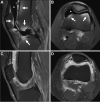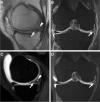SSR white paper: guidelines for utilization and performance of direct MR arthrography
- PMID: 37566148
- PMCID: PMC10730654
- DOI: 10.1007/s00256-023-04420-6
SSR white paper: guidelines for utilization and performance of direct MR arthrography
Erratum in
-
Correction to: SSR white paper: guidelines for utilization and performance of direct MR arthrography.Skeletal Radiol. 2024 Feb;53(2):245. doi: 10.1007/s00256-023-04452-y. Skeletal Radiol. 2024. PMID: 37695344 Free PMC article. No abstract available.
Abstract
Objective: Direct magnetic resonance arthrography (dMRA) is often considered the most accurate imaging modality for the evaluation of intra-articular structures, but utilization and performance vary widely without consensus. The purpose of this white paper is to develop consensus recommendations on behalf of the Society of Skeletal Radiology (SSR) based on published literature and expert opinion.
Materials and methods: The Standards and Guidelines Committee of the SSR identified guidelines for utilization and performance of dMRA as an important topic for study and invited all SSR members with expertise and interest to volunteer for the white paper panel. This panel was tasked with determining an outline, reviewing the relevant literature, preparing a written document summarizing the issues and controversies, and providing recommendations.
Results: Twelve SSR members with expertise in dMRA formed the ad hoc white paper authorship committee. The published literature on dMRA was reviewed and summarized, focusing on clinical indications, technical considerations, safety, imaging protocols, complications, controversies, and gaps in knowledge. Recommendations for the utilization and performance of dMRA in the shoulder, elbow, wrist, hip, knee, and ankle/foot regions were developed in group consensus.
Conclusion: Although direct MR arthrography has been previously used for a wide variety of clinical indications, the authorship panel recommends more selective application of this minimally invasive procedure. At present, direct MR arthrography remains an important procedure in the armamentarium of the musculoskeletal radiologist and is especially valuable when conventional MRI is indeterminant or results are discrepant with clinical evaluation.
Keywords: Direct MR arthrography; Labrum; Ligament; MRI; Meniscectomy; Plica; Post-operative.
© 2023. The Author(s).
Conflict of interest statement
The authors declare no competing interests.
Figures





















Similar articles
-
Direct MR arthrography without image guidance: a practical guide, joint-by-joint.Skeletal Radiol. 2025 Jan;54(1):17-26. doi: 10.1007/s00256-024-04709-0. Epub 2024 May 27. Skeletal Radiol. 2025. PMID: 38801542 Review.
-
Diagnostic value of US, MR and MR arthrography in shoulder instability.Injury. 2013 Sep;44 Suppl 3:S26-32. doi: 10.1016/S0020-1383(13)70194-3. Injury. 2013. PMID: 24060014
-
Direct MR arthrography of the hip joint: anterior approach without imaging guidance.Skeletal Radiol. 2024 Apr;53(4):753-759. doi: 10.1007/s00256-023-04482-6. Epub 2023 Oct 24. Skeletal Radiol. 2024. PMID: 37872371
-
[Direct MR arthrography of the wrist- value in detecting complete and partial defects of intrinsic ligaments and the TFCC in comparison with arthroscopy].Rofo. 2003 Nov;175(11):1515-24. doi: 10.1055/s-2003-43404. Rofo. 2003. PMID: 14610703 German.
-
MR arthrography: is it worthwhile?Top Magn Reson Imaging. 1996 Feb;8(1):24-43. Top Magn Reson Imaging. 1996. PMID: 8820092 Review.
Cited by
-
Impact of gadolinium-based MRI contrast agent and local anesthetics co-administration on chondrogenic gadolinium uptake and cytotoxicity.Heliyon. 2024 Apr 15;10(8):e29719. doi: 10.1016/j.heliyon.2024.e29719. eCollection 2024 Apr 30. Heliyon. 2024. PMID: 38681575 Free PMC article.
-
SCOPE-MRI: Bankart Lesion Detection as a Case Study in Data Curation and Deep Learning for Challenging Diagnoses.ArXiv [Preprint]. 2025 Apr 29:arXiv:2504.20405v1. ArXiv. 2025. PMID: 40395941 Free PMC article. Preprint.
-
MRI detection of senescent cells in porcine knee joints with a β-galactosidase responsive Gd-chelate.Npj Imaging. 2025;3(1):18. doi: 10.1038/s44303-025-00078-y. Epub 2025 May 3. Npj Imaging. 2025. PMID: 40330124 Free PMC article.
-
Prevalence and origin of prominent nutrient channels of the ilium bone on MR-imaging.Skeletal Radiol. 2025 Oct;54(10):2127-2135. doi: 10.1007/s00256-025-04938-x. Epub 2025 May 29. Skeletal Radiol. 2025. PMID: 40439734
-
Pediatric menisci: normal aspects, anatomical variants, lesions, tears, and postsurgical findings.Insights Imaging. 2024 Dec 12;15(1):295. doi: 10.1186/s13244-024-01867-6. Insights Imaging. 2024. PMID: 39666127 Free PMC article.
References
Publication types
MeSH terms
LinkOut - more resources
Full Text Sources
Medical

